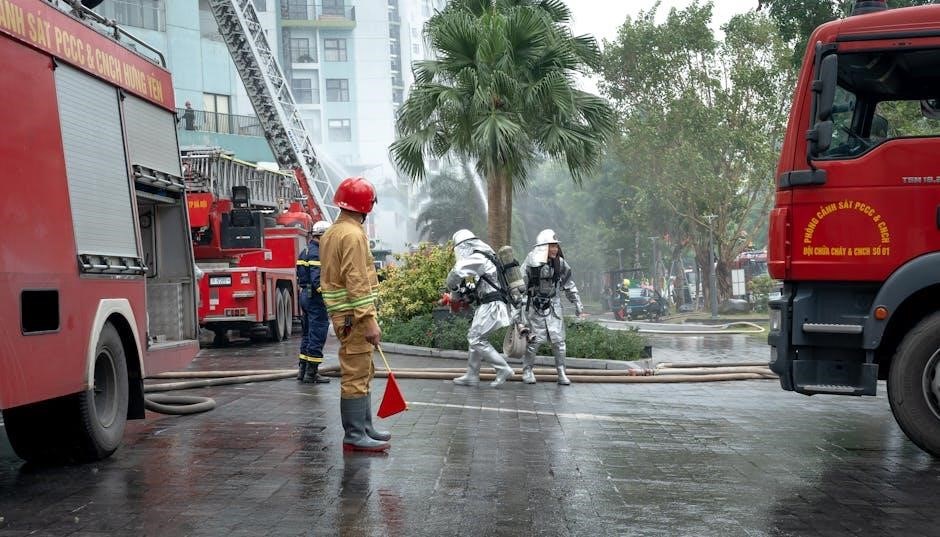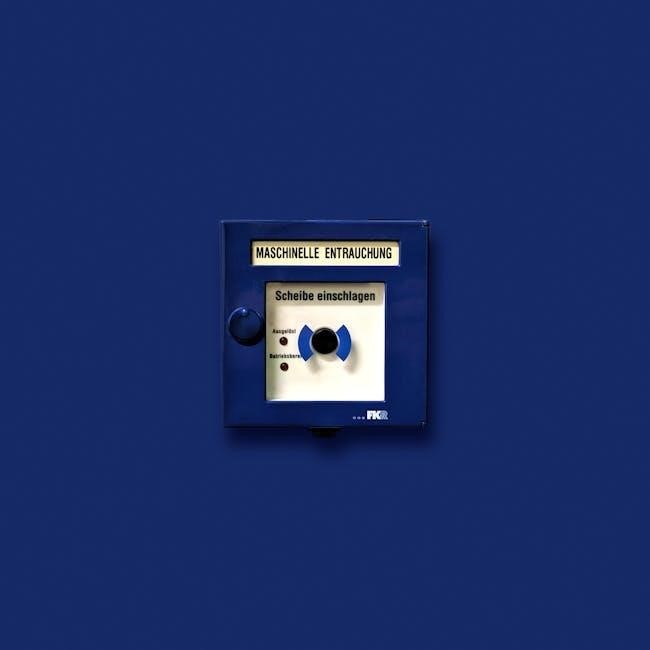
Overview of First Alert Smoke and Carbon Monoxide Alarms
First Alert smoke and carbon monoxide alarms are designed to provide early warning of potential dangers in the home․ These alarms are equipped with advanced technology to detect smoke and carbon monoxide particles in the air․ The alarms are available in various models‚ including battery-powered and hardwired options‚ to suit different needs and preferences․ With a focus on safety and reliability‚ First Alert smoke and carbon monoxide alarms are a popular choice among homeowners․ The alarms are designed to be easy to install and maintain‚ with clear instructions provided in the manual․ By installing First Alert smoke and carbon monoxide alarms‚ homeowners can have peace of mind knowing they are protected from potential hazards․ The alarms are also designed to be compatible with other safety devices‚ providing a comprehensive safety solution for the home․ Overall‚ First Alert smoke and carbon monoxide alarms are a vital component of home safety․
Features of First Alert Smoke Alarm Carbon Monoxide Manual
Key features include interconnectivity and digital display with battery back-up options for enhanced safety and convenience online today always․
Smart Interconnect Feature for Smoke and CO Alarms
The smart interconnect feature allows for seamless connectivity between smoke and CO alarms‚ enabling a unified warning system in the event of an emergency‚ enhancing overall home safety and security measures․
This feature is particularly useful in large homes or homes with multiple levels‚ as it ensures that all occupants are alerted in the event of a potential hazard‚ regardless of their location within the home․
The interconnect feature is also compatible with most First Alert and BRK branded smoke‚ CO‚ and heat alarms‚ making it a versatile and convenient option for homeowners seeking to integrate their safety devices․
By utilizing this feature‚ homeowners can create a comprehensive safety network that provides enhanced protection and peace of mind‚ which is essential for any home․
The smart interconnect feature is a valuable component of the First Alert smoke alarm carbon monoxide manual‚ providing users with a reliable and efficient means of ensuring their safety and security․
AC Powered with Battery Back-up and Digital Display
The First Alert smoke alarm carbon monoxide manual outlines the benefits of an AC powered device with battery back-up‚ providing uninterrupted protection against smoke and carbon monoxide hazards․
The digital display feature allows users to easily monitor the device’s status and receive clear readings of carbon monoxide levels‚ ensuring prompt action can be taken in the event of a potential threat․
This combination of features provides homeowners with a reliable and user-friendly safety solution‚ enhancing their overall sense of security and well-being․
The AC powered design with battery back-up ensures continuous operation‚ even during power outages‚ while the digital display offers a convenient and intuitive means of monitoring the device’s performance․
The integration of these features in the First Alert smoke alarm carbon monoxide manual demonstrates a commitment to providing comprehensive and effective safety solutions for homeowners․

Importance of Reading the Manual
Reading the manual is essential for proper installation and operation with safety precautions and guidelines provided for user reference online today always․
Proper Placement for Smoke Alarms and CO Alarms
Proper placement of smoke alarms and CO alarms is crucial for effective detection and warning․ The manual provides guidelines for installation in various locations‚ including bedrooms‚ hallways‚ and living areas․ It is essential to place smoke alarms on every level of the home and inside each sleeping room․ CO alarms should be installed on every level of the home and near sleeping areas․ The manual also recommends avoiding areas near cooking appliances‚ bathrooms‚ and garages․ By following the placement guidelines‚ homeowners can ensure their smoke and CO alarms are working correctly and providing optimal protection․ The manual’s instructions are designed to help users install their alarms correctly and maintain them over time‚ ensuring the safety of their families and homes․ Proper placement is key to a safe and secure home environment․
Understanding Alarm Life Expectancy and Expiration
Understanding alarm life expectancy and expiration is vital for maintaining a safe home environment․ The manual explains that smoke alarms have a limited lifespan and should be replaced every 10 years․ This is because the sensors and other components can degrade over time‚ reducing the alarm’s effectiveness․ The National Fire Protection Association recommends replacing smoke alarms after 10 years of service․ Additionally‚ CO alarms typically have a shorter lifespan and may need to be replaced every 5-7 years․ The manual provides guidance on how to determine the age of an alarm and when it should be replaced․ By understanding alarm life expectancy and expiration‚ homeowners can ensure their alarms are functioning properly and providing adequate protection․ Regular replacement of outdated alarms is essential for maintaining a safe and secure home․ The manual’s instructions help users stay on top of alarm maintenance and replacement․

First Alert Consumer Support
First Alert offers consumer support through phone and online resources with helpful staff available to answer questions and provide assistance every day․
Hours of Operation and Contact Information
The company’s hours of operation and contact information are readily available to customers‚ with a dedicated support team waiting to assist with any queries or concerns․
The customer support team can be reached through a toll-free phone number‚ 1-800-323-9005‚ and are available to provide help and guidance on various topics‚ including product installation and maintenance․
Additionally‚ customers can also visit the company’s website to access a wealth of information and resources‚ including user manuals‚ FAQs‚ and troubleshooting guides․
The website is designed to be user-friendly and easy to navigate‚ allowing customers to quickly find the information they need․
Overall‚ the company’s commitment to customer support and satisfaction is evident in the range of resources and services they provide‚ making it easy for customers to get the help they need when they need it․
The support team is knowledgeable and experienced‚ and are able to provide expert advice and guidance on a range of topics․

Regulatory Requirements and Compliance
First alert smoke alarm carbon monoxide manual meets regulatory requirements and compliance standards with UL217 certification for safety and reliability purposes online always․
UL217 Compliance for Smoke Alarms
UL217 compliance is a critical aspect of smoke alarm safety‚ ensuring that devices meet specific standards for detection and warning capabilities․ The First Alert smoke alarm carbon monoxide manual adheres to these guidelines‚ providing users with a reliable means of protection against potential hazards․ By meeting UL217 compliance‚ the smoke alarm is designed to detect particles of combustion‚ alerting occupants to potential dangers․ This certification is a testament to the device’s ability to perform under various conditions‚ including different types of fires and environmental factors․ As a result‚ users can trust that their First Alert smoke alarm is equipped to handle a range of situations‚ providing peace of mind and enhanced safety features․ The manual outlines the specifics of UL217 compliance and its implications for smoke alarm performance and reliability․ Overall‚ UL217 compliance is essential for ensuring the effectiveness of smoke alarms․

and Final Thoughts
Importance of Replacing Smoke Alarms Every 10 Years
The importance of replacing smoke alarms every 10 years cannot be overstated‚ as it is crucial for ensuring the safety and protection of individuals and properties․ According to the National Fire Protection Association‚ smoke alarms should be replaced every 10 years or according to the manufacturer’s instructions․ This is because smoke alarms have a limited lifespan and their sensitivity may decrease over time‚ making them less effective at detecting fires․ Replacing smoke alarms every 10 years helps to ensure that they are functioning properly and can provide early warning in the event of a fire․ It is also important to note that some smoke alarms have a 10-year battery life‚ making replacement easier and more convenient․ By replacing smoke alarms every 10 years‚ individuals can have peace of mind knowing that they are protected in the event of a fire․ Proper replacement is essential for safety․




